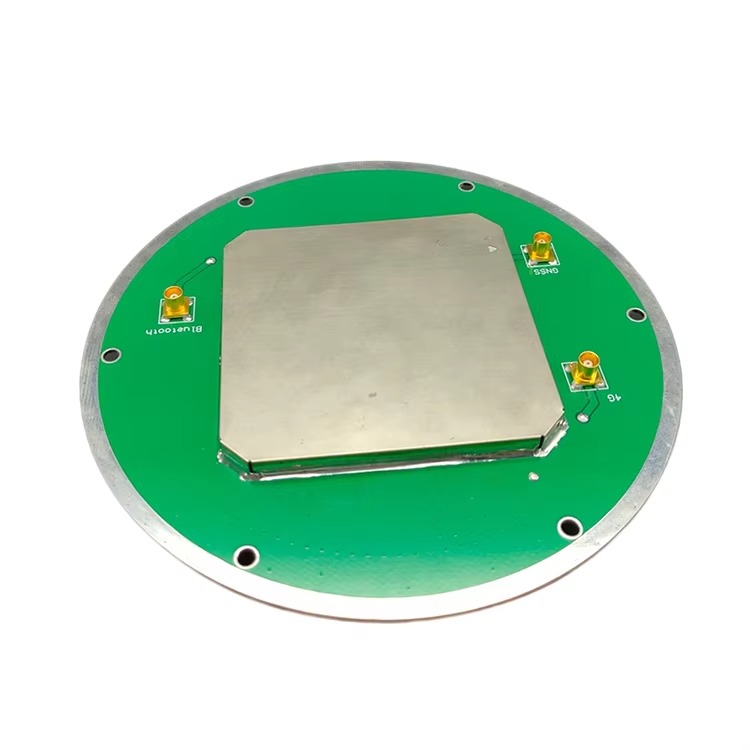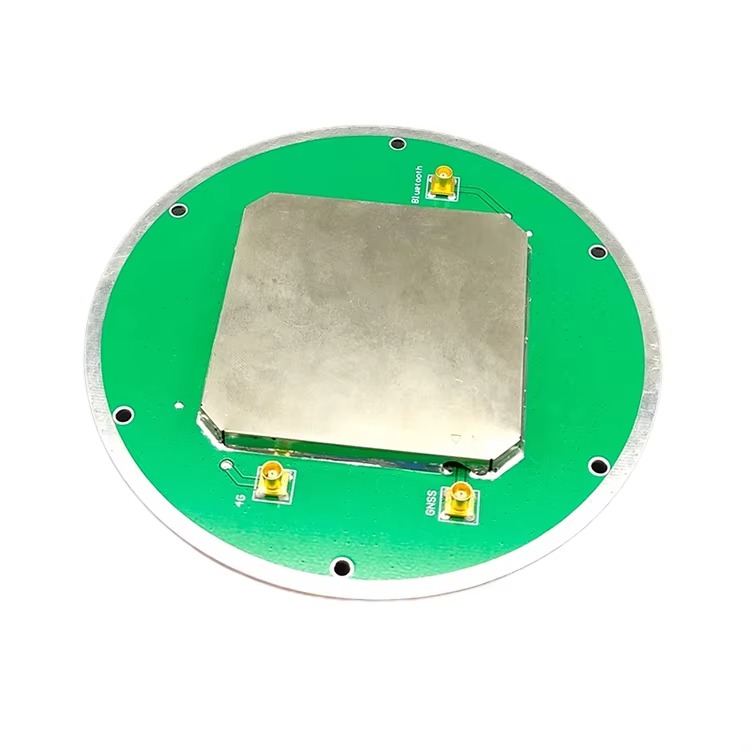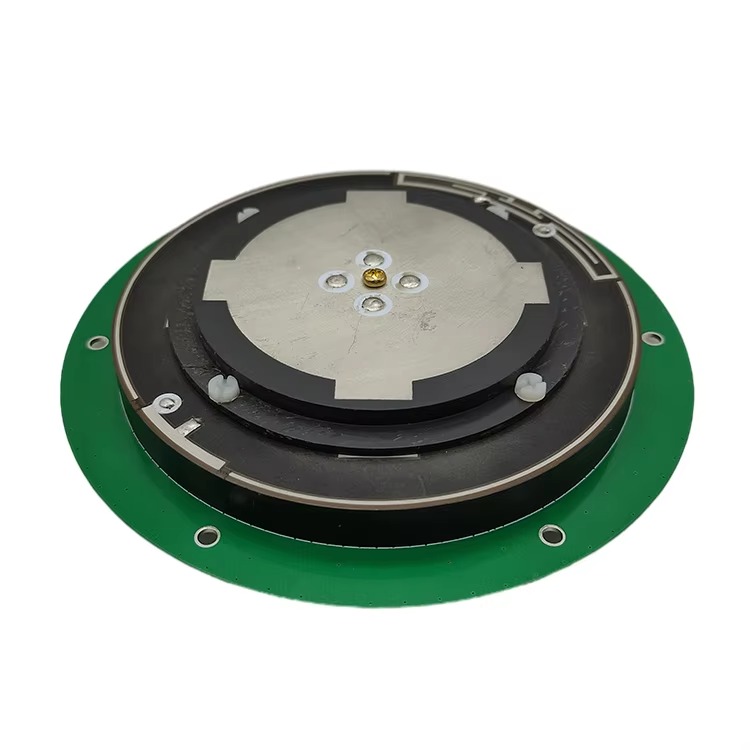5.1 Current Applications Across Industries
5.1.1 Construction and Infrastructure Development
The construction industry is the largest adopter of RTK GNSS Antennas with Tilt Compensation, using them to streamline site layout, machine guidance, and structural monitoring. In site layout— the process of marking the position of buildings, roads, and utilities on the ground— tilt-compensated antennas eliminate the need for manual leveling, allowing surveyors to mark points 2–3 times faster than with traditional RTK. For example, during the construction of a residential subdivision, a survey team using tilt-compensated antennas can mark the location of 100 house foundations in a single day, compared to 30–40 with traditional antennas. This speedup reduces the time between design approval and construction start, accelerating project timelines.
Machine guidance is another key application. Tilt-compensated antennas are mounted on excavators, graders, and pavers to guide operators in real time, ensuring that the machinery follows the design plans with centimeter-level accuracy. On sl
oped terrain, such as a highway construction site with slopes of 8–12 degrees, a grader equipped with a tilt-compensated antenna can precisely shape the roadbed to the required elevation without frequent stops for manual leveling. A construction company in Canada reported that using tilt-compensated antennas on their grading fleet reduced the time required to prepare a 5-kilometer highway section by 25%, from 4 weeks to 3 weeks. The antennas also reduced material waste by 10%, as the grader’s precise movements ensured that only the necessary amount of soil was removed or added.
Structural monitoring is a growing application for tilt-compensated antennas, especially for large-scale infrastructure like bridges, dams, and skyscrapers. These structures can experience small movements over time due to temperature changes, wind, or soil settlement, and monitoring these movements requires high-precision positioning. Tilt-compensated antennas are mounted on the structure’s surface, where they can operate even if the mounting point is slightly tilted (e.g., due to minor structural movement). The antennas continuously collect position data, which is analyzed to detect any abnormal shifts. For example, a bridge monitoring project in Europe used 12 tilt-compensated antennas to track the bridge’s movement over a 2-year period. The antennas detected a 3-millimeter lateral shift during high winds, which was within the safe range, but also identified a 5-millimeter settlement in one pier— prompting early maintenance that prevented further damage. The project demonstrated that tilt-compensated antennas are more reliable than traditional monitoring systems, which often require manual leveling and can miss small movements.
5.1.2 Precision Agriculture
Precision agriculture relies on accurate positioning to optimize crop yields, reduce resource waste, and minimize environmental impact— and RTK GNSS Antennas with Tilt Compensation have become a key enabler of this technology. In agricultural applications, the antennas are mounted on a variety of equipment, including tractors, sprayers, harvesters, and planters, where they operate on hilly fields and uneven terrain.
One of the most common uses is in variable-rate application (VRA) of fertilizers, pesticides, and water. VRA systems use GNSS positioning to map the field’s soil fertility and crop health, then adjust the amount of inputs applied to each area based on this data. For this to work, the equipment’s position must be accurate to within a few centimeters— even on slopes. A traditional RTK antenna on a sprayer would introduce errors on hilly terrain, leading to over-application in some areas and under-application in others. Tilt-compensated antennas correct these errors, ensuring that the VRA system applies the right amount of inputs exactly where needed. A study by the U.S. Department of Agriculture (USDA) found that farmers using tilt-compensated antennas in VRA systems reduced fertilizer use by 12–15% while increasing crop yields by 4–6%, compared to farmers using traditional RTK or GPS systems.
Another application is in auto-steer systems for tractors and harvesters. Auto-steer systems use GNSS positioning to guide the equipment along a pre-planned path, reducing operator fatigue and ensuring that the equipment covers the field without overlapping or missing areas. On uneven terrain, a traditional auto-steer system with a non-tilt-compensated antenna may drift off course, leading to overlapping passes that waste fuel and time. Tilt-compensated antennas keep the auto-steer system on track, even on slopes of up to 15 degrees. A farmer in Iowa, USA, reported that using a tilt-compensated antenna on his tractor’s auto-steer system reduced overlapping passes by 8%, saving approximately 10 hours of work and 50 gallons of fuel per season on a 500-acre farm.
Planters also benefit from tilt-compensated antennas, as they ensure that seeds are planted at the correct depth and spacing— critical factors for germination and crop growth. On sloped fields, a traditional planter’s depth control system may be thrown off by the terrain, leading to uneven planting. A tilt-compensated antenna provides accurate positioning data that the planter’s control system uses to adjust the depth of the seed drills in real time. A study by a leading agricultural equipment manufacturer found that planters equipped with tilt-compensated antennas had a 95% seed spacing accuracy on slopes, compared to 80% for planters with traditional RTK antennas. This improved accuracy led to more uniform crop emergence and a 3–4% increase in yield.
5.1.3 UAV Surveying and Mapping
The rise of UAVs (drones) in surveying and mapping has created a high demand for compact, lightweight, and accurate GNSS antennas— and RTK GNSS Antennas with Tilt Compensation have become the preferred choice for high-precision UAV applications. UAVs experience constant tilt during flight (pitch and roll) as they adjust their altitude, navigate obstacles, and turn— making traditional RTK antennas unsuitable, as they would produce large positioning errors. Tilt-compensated antennas correct for this dynamic tilt, delivering centimeter-level accuracy that is essential for applications like 3D modeling, construction site monitoring, and land surveying.
One of the most important UAV applications is in construction site mapping. Construction companies use UAVs equipped with cameras and LiDAR sensors to capture high-resolution images and 3D point clouds of the site, which are used to track progress, detect errors, and compare the actual construction to the design plans. For this data to be useful, each pixel in the image or point in the point cloud must be tagged with an accurate GNSS position. A UAV with a traditional RTK antenna would produce positioning errors of 10–20 cm during flight, leading to inaccuracies in the 3D model. A tilt-compensated antenna reduces these errors to 1–2 cm, ensuring that the model accurately reflects the site’s conditions. A construction company in the United Kingdom used a UAV with a tilt-compensated antenna to map a 10-acre construction site every week. The accurate 3D models allowed the company to detect a 5-centimeter misalignment in a concrete foundation early, saving $50,000 in rework costs.
UAVs with tilt-compensated antennas are also used in land surveying, especially in remote or difficult-to-access areas like forests, mountains, and wetlands. Traditional ground surveying in these areas is time-consuming and dangerous, but UAVs can cover large areas quickly and safely. The tilt-compensated antenna ensures that the UAV’s position is accurate even when flying over uneven terrain or in windy conditions. A surveying firm in Brazil used a UAV with a tilt-compensated antenna to survey a 50-square-kilometer forest reserve. The firm completed the survey in 3 days, compared to 2 weeks using traditional ground surveying methods. The survey data was used to create a detailed map of the reserve’s vegetation and topography, which was critical for a conservation project.
Another emerging UAV application is in power line and pipeline inspection. UAVs equipped with cameras and sensors inspect power lines for damage, corrosion, or vegetation encroachment— tasks that were previously done by workers in helicopters or on foot. The UAV’s position must be accurate to within a few centimeters to ensure that the inspection covers every part of the line and that any defects are mapped correctly. Tilt-compensated antennas provide this accuracy, even when the UAV is flying close to power lines and making quick, dynamic movements to avoid obstacles. A utility company in Germany reported that using UAVs with tilt-compensated antennas reduced power line inspection time by 60% and improved the detection rate of small defects (like cracked insulators) by 30%, compared to traditional inspection methods.
5.2 Future Trends Shaping RTK GNSS Antennas with Tilt Compensation
5.2.1 Integration with Advanced Sensor Fusion
The future of tilt-compensated RTK GNSS antennas lies in the integration of more advanced sensor fusion technologies, which will improve their accuracy, reliability, and ability to handle extreme conditions. Currently, most tilt-compensated antennas use 3-axis accelerometers to measure tilt, but future models will combine these accelerometers with other sensors— such as gyroscopes, magnetometers, and even LiDAR— to create a more robust positioning system.
Sensor fusion with gyroscopes (to create 6-axis IMUs) will address the current limitation of vibration sensitivity. Gyroscopes measure angular velocity, which allows the system to distinguish between actual tilt and temporary vibrations. For example, when a tilt-compensated antenna is mounted on a vibrating construction vehicle, the gyroscope will detect the vehicle’s vibration frequency and filter out these signals from the accelerometer data, ensuring that only true tilt is used for correction. This will reduce positioning errors in high-vibration environments by 50–70%, making the antennas suitable for use on equipment like jackhammers and pile drivers.
Adding magnetometers (to create 9-axis IMUs) will improve the antenna’s ability to determine its orientation relative to geographic north, which is critical for converting tilt errors into the correct coordinate system adjustments. Currently, some antennas rely on GNSS heading data to determine orientation, but this can be inaccurate in areas with weak satellite signals (e.g., urban canyons or dense forests). Magnetometers provide a direct measurement of magnetic north, which is more reliable in these conditions. Sensor fusion of accelerometers, gyroscopes, and magnetometers will ensure that the antenna’s tilt correction is accurate even when GNSS signals are poor— expanding its use in challenging environments.
Integration with LiDAR sensors is another promising trend, especially for UAV and mobile mapping applications. LiDAR sensors capture detailed 3D data of the surrounding environment, which can be used to verify and correct the GNSS positioning data. For example, a UAV equipped with a tilt-compensated RTK antenna and a LiDAR sensor can use the LiDAR data to detect changes in the terrain (e.g., a sudden slope) and adjust the tilt correction algorithm in real time. This hybrid system will provide even higher accuracy— potentially sub-centimeter— and will be useful in applications like precision mapping of historical sites or monitoring of small structural movements.
5.2.2 Expansion of Tilt Compensation Range and Environmental Resilience
Manufacturers are investing heavily in expanding the tilt compensation range of RTK GNSS antennas, with the goal of covering tilt angles of up to 30–40 degrees. This will be achieved through two key innovations: more advanced MEMS accelerometers and improved correction algorithms.
Next-generation MEMS accelerometers will have a wider dynamic range and higher accuracy, allowing them to measure tilt angles of up to 40 degrees with an error of less than 0.1 degrees. These accelerometers will use new materials and manufacturing techniques, such as silicon carbide (SiC) or gallium nitride (GaN), which are more resistant to temperature changes and vibration. For example, a SiC-based accelerometer can operate in temperatures ranging from -60°C to 125°C, compared to -40°C to 85°C for traditional silicon accelerometers— making it suitable for use in polar regions, deserts, and industrial environments.
Improved correction algorithms will also play a role in expanding the tilt range. Current algorithms use simple trigonometric calculations (E = h × sin(θ)) to correct for tilt, but these become less accurate at angles above 20 degrees due to the nonlinear relationship between tilt angle and positioning error. Future algorithms will use more complex mathematical models, such as polynomial regression or machine learning (ML) models, to calculate errors at higher tilt angles. ML models, in particular, will be trained on large datasets of tilt and positioning data, allowing them to adapt to different environments and tilt scenarios. For example, an ML-based algorithm could learn to correct for tilt in a UAV during aggressive turns, where the tilt angle changes rapidly, by recognizing patterns in the sensor data.
Environmental resilience will also be a key focus of future development. Manufacturers will improve the antenna’s resistance to saltwater, dust, and vibration by using new enclosure materials and sealing technologies. For example, some future antennas may use a ceramic radome instead of plastic, which is more resistant to corrosion and UV radiation. Sealing technologies like laser welding will replace traditional gaskets, creating a hermetic seal that prevents moisture and dust from entering the enclosure— improving the antenna’s IP rating to IP69 (which withstands high-pressure water jets) or higher. These improvements will extend the antenna’s lifespan in harsh environments, reducing maintenance costs and downtime.
5.2.3 Miniaturization and Low-Power Design for Edge Devices
As the Internet of Things (IoT) and edge computing grow in popularity, there will be a demand for smaller, lower-power RTK GNSS Antennas with Tilt Compensation that can be integrated into edge devices— such as wearable sensors, small UAVs, and smart agricultural equipment. Miniaturization and low-power design will be key trends in the coming years, driven by advancements in microelectronics and energy-efficient technologies.
Miniaturization will be achieved through the development of smaller MEMS sensors and integrated circuits (ICs). For example, a next-generation MEMS accelerometer could be as small as 1 mm × 1 mm, compared to 3 mm × 3 mm for current models. Integrated circuits will also become more compact, with the GNSS receiver, tilt sensor, and signal processing unit combined into a single chip (a system-on-chip, or SoC). This will reduce the antenna’s size by 50–70%, making it suitable for use in wearable devices like smart glasses for surveyors. A surveyor wearing smart glasses with a miniaturized tilt-compensated antenna could see real-time positioning data overlaid on their field of view, allowing them to mark survey points without carrying a separate antenna or receiver.
Low-power design will be critical for edge devices, which often run on batteries and need to operate for long periods without recharging. Future tilt-compensated antennas will use energy-efficient components, such as low-power LNAs and microcontrollers, and will incorporate power management techniques like duty cycling. Duty cycling involves turning off non-essential components (e.g., the tilt sensor) when the antenna is not in use, then waking them up quickly when needed. For example, an antenna used in a smart agricultural sensor could wake up every 10 minutes to take a position measurement, then go back to sleep— reducing power consumption by 80–90% compared to a continuously operating antenna.
Another low-power technology is energy harvesting, which allows the antenna to generate its own power from the environment. For example, a tilt-compensated antenna mounted on a tractor could use vibration energy harvesting to convert the tractor’s vibration into electricity, powering the antenna without relying on a battery. Solar energy harvesting could also be used for antennas mounted on UAVs or fixed structures, with a small solar panel integrated into the radome. These technologies will make tilt-compensated antennas more sustainable and reduce their reliance on disposable batteries— a key benefit for remote applications where battery replacement is difficult.
Conclusion
RTK GNSS Antennas with Tilt Compensation have transformed the field of precision positioning, addressing a critical limitation of traditional RTK systems: the need for manual leveling. By integrating MEMS tilt sensors and real-time correction algorithms, these antennas deliver centimeter-level accuracy even on uneven terrain, moving platforms, and in dynamic environments— opening up RTK technology to a wide range of applications across construction, agriculture, UAV surveying, and marine industries.
Throughout this examination, we have seen how the design and construction of these antennas— from their multi-element GNSS arrays and 3-axis MEMS accelerometers to their rugged enclosures and versatile mounting systems— are optimized for performance and reliability. Their working principles, which combine RTK carrier-phase positioning with real-time tilt error calculation and correction, ensure that even small tilt angles do not compromise accuracy. The advantages of these antennas are clear: they reduce field work time and labor costs by eliminating manual leveling, improve accuracy in dynamic environments, and enhance versatility across multiple platforms. A highway construction project, for example, cut survey time by 60% using tilt-compensated antennas, while a precision farmer reduced fertilizer use by 15% and increased yields by 6%— demonstrating their tangible impact on productivity and sustainability.
However, challenges remain. The limited tilt compensation range (15–20 degrees) restricts their use in extreme terrain, while sensitivity to vibration and environmental factors can degrade performance in harsh conditions. Higher costs and complexity also present barriers for small businesses and budget-constrained projects. These challenges, however, are being addressed through ongoing innovations: advanced sensor fusion (combining accelerometers, gyroscopes, and LiDAR) to improve accuracy and vibration resistance, new materials and algorithms to expand the tilt range and environmental resilience, and miniaturization and low-power design to integrate the antennas into edge devices.
Looking ahead, the future of RTK GNSS Antennas with Tilt Compensation is bright. As sensor fusion, ML-based correction algorithms, and energy harvesting technologies mature, these antennas will become even more accurate, reliable, and accessible. They will play a key role in the growth of precision agriculture, smart construction, and autonomous systems— enabling new applications that we can only begin to imagine, such as fully autonomous UAVs for precision mapping or self-driving agricultural equipment that operates seamlessly on hilly terrain.
In conclusion, RTK GNSS Antennas with Tilt Compensation are more than just a technical innovation— they are a catalyst for efficiency, sustainability, and safety in industries that rely on precision positioning. By eliminating the need for manual leveling and adapting to dynamic environments, they have made high-precision GNSS technology more accessible and practical than ever before. As technology continues to advance, these antennas will remain at the forefront of precision geospatial measurement, driving progress and innovation for years to come.




































































 Language
Language
 En
En Cn
Cn Korean
Korean

 Home >
Home > 







 18665803017 (Macro)
18665803017 (Macro)













